
Theodore Sturgeon was an American fiction author of primarily fantasy, science fiction and horror, as well as a critic. He wrote approximately 400 reviews and more than 120 short stories, 11 novels and several Star Trek scripts.

Dragonflight is a science fiction novel by the American-Irish author Anne McCaffrey. It is the first book in the Dragonriders of Pern series. Dragonflight was first published by Ballantine Books in July 1968. It is a fix-up of novellas, including two which made McCaffrey the first woman writer to win a Hugo and Nebula Award.

Anne Inez McCaffrey was an American-Irish writer known for the Dragonriders of Pern science fiction series. She was the first woman to win a Hugo Award for fiction and the first to win a Nebula Award. Her 1978 novel The White Dragon became one of the first science-fiction books to appear on the New York Times Best Seller list.
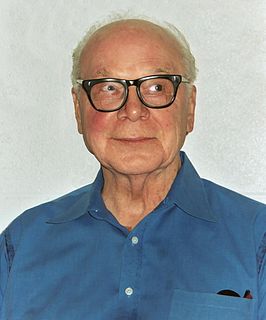
Philip José Farmer was an American author known for his science fiction and fantasy novels and short stories.

A novella is a narrative prose fiction whose length is shorter than that of most novels, but longer than most short stories. The English word novella derives from the Italian novella, feminine of novello, which means "new".

Riders of the Purple Wage is a science fiction novella by American writer Philip José Farmer. It appeared in Dangerous Visions, the New Wave science fiction anthology compiled by Harlan Ellison, in 1967, and won the Hugo Award for best novella in 1968, jointly with Weyr Search by Anne McCaffrey.

Robert Silverberg is an American author and editor, best known for writing science fiction. He is a multiple winner of both Hugo and Nebula Awards, a member of the Science Fiction and Fantasy Hall of Fame, and a Grand Master of SF. He has attended every Hugo Awards ceremony since the inaugural event in 1953.
Who Goes There? is a science fiction horror novella by American author John W. Campbell Jr., written under the pen name Don A. Stuart. Its story follows a group of people trapped in an Antarctic research outpost with shapeshifting alien monsters able to absorb and imitate any living being. The novella was first published in the August 1938 issue of Astounding Science Fiction and was also printed as The Thing from Another World. Its extended novel version, found in an early manuscript titled Frozen Hell, was finally published in 2019.

Kate Wilhelm was an American author. She wrote novels and stories in the science fiction, mystery, and suspense genres, including the Hugo Award–winning Where Late the Sweet Birds Sang, and she established the Clarion Workshop with her husband Damon Knight and writer Robin Scott Wilson.
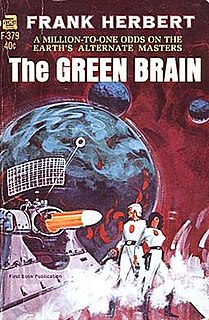
The Green Brain (1966), initially published as Greenslaves, is a science fiction novel by American writer Frank Herbert.
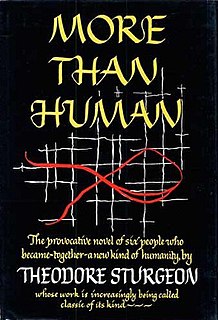
More Than Human is a 1953 science fiction novel by American writer Theodore Sturgeon. It is a revision and expansion of his previously published novella Baby is Three, which is bracketed by two additional parts written for the novel . It won the 1954 International Fantasy Award, which was also given to works in science fiction. It was additionally nominated in 2004 for a "Retro Hugo" award for the year 1954. Science fiction critic and editor David Pringle included it in his book Science Fiction: The 100 Best Novels.

The Fifth Head of Cerberus is the title of both a novella and a single-volume collection of three novellas, written by American science fiction and fantasy author Gene Wolfe, both published in 1972. The novella was included in the anthology Nebula Award Stories Eight.

Mind uploading, whole brain emulation, or substrate-independent minds, is a use of a computer or another substrate as an emulated human brain. The term "mind transfer" also refers to a hypothetical transfer of a mind from one biological brain to another. Uploaded minds and societies of minds, often in simulated realities, are recurring themes in science-fiction novels and films since the 1950s.

The Ship Who Sang (1969) is a science fiction novel by American writer Anne McCaffrey, a fix-up of five stories published 1961 to 1969. By an alternate reckoning, "The Ship Who Sang" is the earliest of the stories, a novelette, which became the first chapter of the book. Finally, the entire "Brain & Brawn Ship series", written by McCaffrey and others, is sometimes called the "Ship Who Sang series" by bibliographers, merchants, or fans.

The Ship Who Searched is a science fiction novel by American writers Anne McCaffrey and Mercedes Lackey. It is the third of seven books in The Ship Who Sang series by McCaffrey and four other authors, and the only one by Lackey. It was first published as a serial in the monthly Amazing Stories, June to September, and as a paperback original by Baen Books in August 1992.

The Science Fiction Hall of Fame, Volume Two is an English language science fiction two-volume anthology edited by Ben Bova and published in the U.S. by Doubleday in 1973, distinguished as volumes "Two A" and "Two B". In the U.K. they were published by Gollancz as Volume Two (1973) and Volume Three (1974). The original U.S. subtitle was The Greatest Science Fiction Novellas of All Time.

Brain Wave is a science fiction novel by American writer Poul Anderson, first published in serial form in Space Science Fiction in 1953, and then as a novel in 1954. Anderson had said that he could consider it one of his top five books. This is one of many science fiction works written at this time on the theme of heightened intelligence.
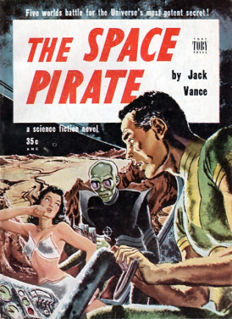
The Five Gold Bands is a science fiction novel by American writer Jack Vance, first published in the November 1950 issue of Startling Stories magazine. It was published in 1953 as a separate book under the title The Space Pirate, and in 1963 it was paired with Vance's Hugo Award-winning novella The Dragon Masters in the form of an Ace Double.
A group mind, group ego, mind coalescence, or gestalt intelligence in science fiction is a plot device in which multiple minds, or consciousnesses, are linked into a single, collective consciousness or intelligence. The first alien hive society was depicted in H. G. Wells's The First Men in the Moon (1901) while the use of human hive minds in literature goes back at least as far as David H. Keller's The Human Termites and Olaf Stapledon's science fiction novel Last and First Men (1930), which is the first known use of the term "group mind" in science fiction. The use of the phrase "hive mind", however, was first recorded in 1943 in use in bee keeping and its first known use in sci-fi was James H. Schmitz's Second Night of Summer (1950). A group mind might be formed by any fictional plot device that facilitates brain to brain communication, such as telepathy.
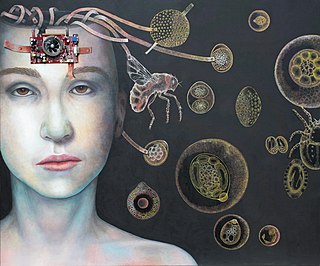
Parasites appear frequently in biology-inspired fiction from ancient times onwards, with a flowering in the nineteenth century. These include intentionally disgusting alien monsters in science fiction films, often with analogues in nature. Authors and scriptwriters have to some extent exploited parasite biology: lifestyles including parasitoid, behaviour-altering parasite, brood parasite, parasitic castrator, and many forms of vampire are found in books and films. Some fictional parasites, like Count Dracula and Alien's Xenomorphs, have become well known in their own right.


















